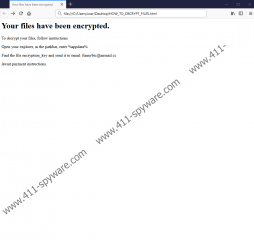XCry Ransomware Removal Guide
It’s not a good day if you suddenly see the XCry Ransomware notification on your screen. Getting infected with ransomware is always a nerve-racking experience, but if this program is already on your computer, there’s one thing you can do: remove XCry Ransomware for good.
If you have your files backed up, you can delete the corrupted data without any remorse and then transfer the healthy copies into your hard drive once you have the malicious infection removed. The fastest and the most efficient way to terminate a malicious infection is removing it with a licensed antispyware tool.
XCry Ransomware was written in the C++ programming language, and this program avoids encrypting files in the %AppData%, %WinDir%, %ProgramFiles(x86)%, and %ProgramFiles% directories. It needs the affected computer to work properly in order to receive the ransom payment. However, we have also found that this program hasn’t been developed fully, and so it cannot connect to its command & control center. As a result, it cannot collect ransom payments or issue the decryption keys for the infected users. In other words, paying anything to these criminals is futile.
It is necessary to emphasize that XCry Ransomware is just one of the many ransomware infections out there, and it is important to understand how they spread. If one learns to recognize the aspects of ransomware distribution, it is possible to avoid getting infected with similar programs in the future. Since ransomware programs usually get distributed through spam emails, you need to be careful each time you encounter a message from an unfamiliar sender. Just because the topic of a mail message looks urgent, it is does not mean that you have to open the received files at once. It is always possible to scan the received files with a security tool of your choice, and you wouldn’t have to deal with XCry Ransomware or any other similar infection.
As far as the behavior of this infection is concerned, once XCry Ransomware is done with the file encryption, it displays the following message:
You files have been encrypted.
To decrypt your files, follow instructions
Open your explorer, in the pathbar, enter %appdata%
Find the file encryption_key and sent it to email: funnybtc@airmail.cc
Await payment instructions.
As you can see, XCry Ransomware does not even say how much it wants from you for the file decryption (although we have already established that this program cannot issue the decryption key because it cannot connect to its command and control center). You just need to remove this infection from your system immediately.
If you check out the manual removal instructions below, you will see that they are quite long because XCry Ransomware creates a point of execution and drops a few files in the target system. If you find it too complicated, you can delete this ransomware infection with a licensed antispyware tool.
It might not be possible to restore your files, but we believe that you can find important data saved on your mobile device or in your inbox. However, it is very often that users save their files in a number of places, so at least part of them can be retrieved. Just do not forget to protect your system from various threats.
How to Delete XCry Ransomware
- Press Ctrl+Shift+Esc and open Task Manager.
- Click the Processes tab and mark unfamiliar processes.
- Press End Process to close them and exit Task Manager.
- Delete recently downloaded files from Desktop.
- Remove recently downloaded files from your Downloads folder.
- Press Win+R and enter %Temp%. Press OK.
- Delete the recently downloaded files from the directory.
- Press Win+R and enter regedit. Press OK.
- Open HKEY_CURRENT_USER\Software\Microsoft\Windows\CurrentVersion\Run.
- On the right side, right-click a random-name value.
- Choose to delete the value and exit Registry Editor.
- Press Win+R and enter %AppData%. Press OK.
- Delete the random-name executable file.
- Scan your computer with SpyHunter.
XCry Ransomware Screenshots:

XCry Ransomware technical info for manual removal:
Files Modified/Created on the system:
| # | File Name | File Size (Bytes) | File Hash |
|---|---|---|---|
| 1 | e32c8b2da15e294e2ad8e1df5c0b655805d9c820e85a33e6a724b65c07d1a043.exe | 446018 bytes | MD5: 7475713df82b2a81b2d32715a94c2b63 |
Memory Processes Created:
| # | Process Name | Process Filename | Main module size |
|---|---|---|---|
| 1 | e32c8b2da15e294e2ad8e1df5c0b655805d9c820e85a33e6a724b65c07d1a043.exe | e32c8b2da15e294e2ad8e1df5c0b655805d9c820e85a33e6a724b65c07d1a043.exe | 446018 bytes |

